You are here
Gallery
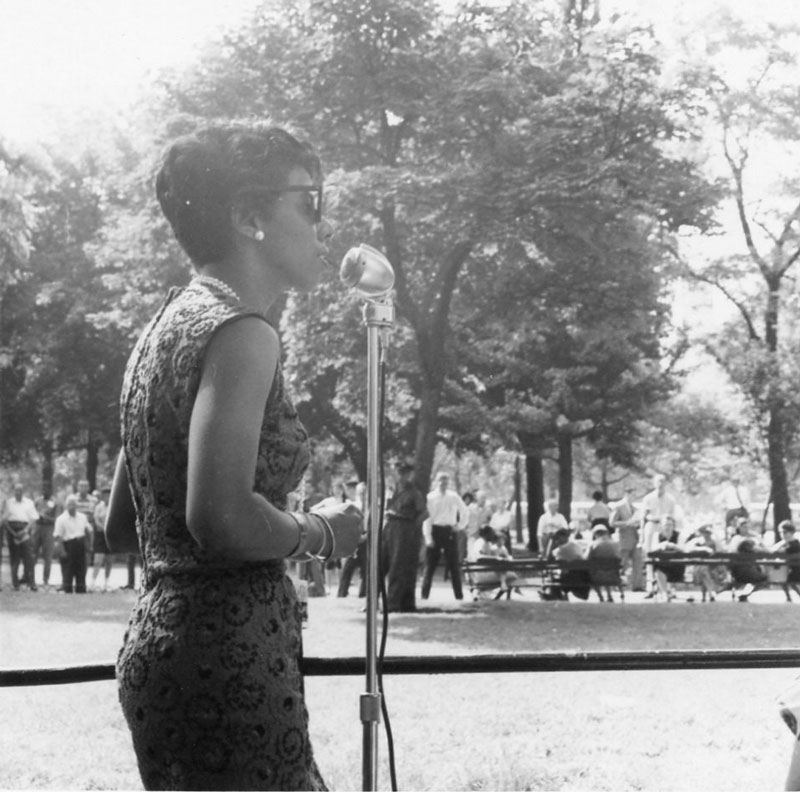
Lorraine Hansberry speaking at “Village Rallies for NAACP,” in Washington Square Park, June 13, 1959. Photographer unknown. Hansberry was the co-chair of the National Association for the Advancement of Colored People Life Membership Committee. The rally was to increase membership, raise funds, and to start a Greenwich Village NAACP branch.
 Lorraine Hansberry speaking at “Village Rallies for NAACP,” in Washington Square Park, June 13, 1959. Photographer unknown.
Lorraine Hansberry speaking at “Village Rallies for NAACP,” in Washington Square Park, June 13, 1959. Photographer unknown. 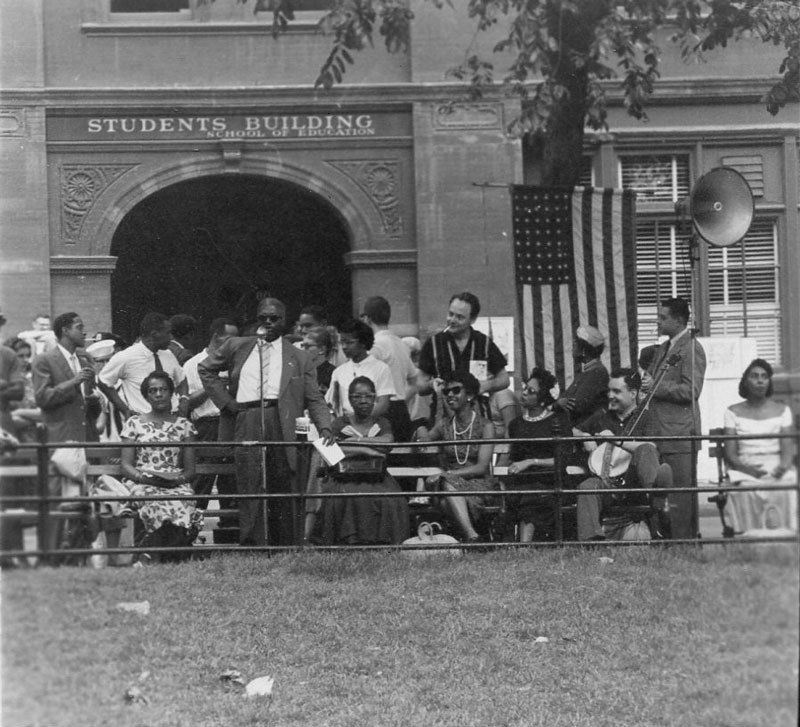
Daisy Bates, Lorraine Hansberry, and Robert Nemiroff at “Village Rallies for NAACP,” in Washington Square Park, June 13, 1959. Photographer unknown. Hansberry was the co-chair of the National Association for the Advancement of Colored People Life Membership Committee. Daisy Lee Gatson Bates was the president of the NAACP Arkansas State Conference of Branches and advisor to the Little Rock Nine, the high school students who desegregates the all-white Central High School in 1957.
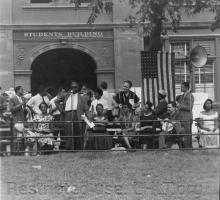 Daisy Bates, Lorraine Hansberry, and Robert Nemiroff at “Village Rallies for NAACP,” in Washington Square Park, June 13, 1959. Photographer unknown.
Daisy Bates, Lorraine Hansberry, and Robert Nemiroff at “Village Rallies for NAACP,” in Washington Square Park, June 13, 1959. Photographer unknown. 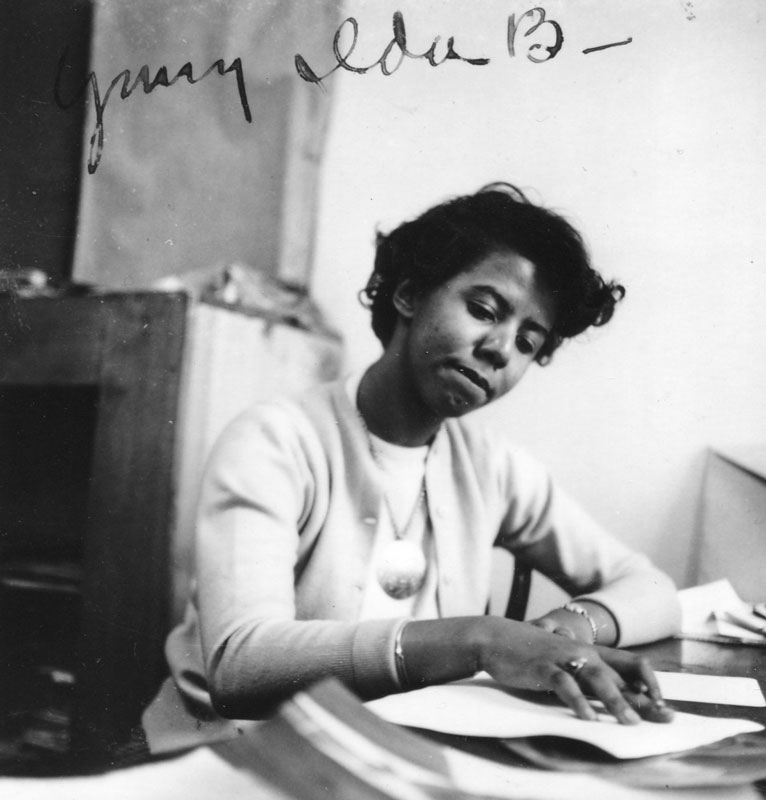
Lorraine Hansberry—“A Young “Ida B.”—writing at her desk at Freedom magazine, 1952. Photographer unknown. From 1951–1953, Hansberry worked in Harlem at the balck magazine, Freedom, founded by Paul Robeson and Louis E. Burnham. Following in the footsteps of Ida B. Wells-Barnett, an African-American journalist, newspaper editor, suffragist, activist for women’s rights, and anti-lynching crusader, one of Hansberry’s first reports covered over 100 pro-Communist black women, “Sojourners for Truth and Justice,” who were convened in Washington, DC by Mary Church Terrell. Hansberry also covered the case of Willie McGee, a black man sentenced to death for raping a white woman in 1945 Mississippi; she was inspired to write the poem “Lynchsong” about his case.
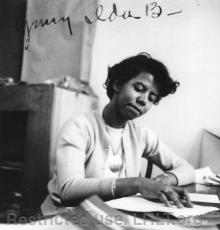 Lorraine Hansberry—“A Young “Ida B.”—writing at her desk at Freedom magazine, 1952. Photographer unknown.
Lorraine Hansberry—“A Young “Ida B.”—writing at her desk at Freedom magazine, 1952. Photographer unknown. 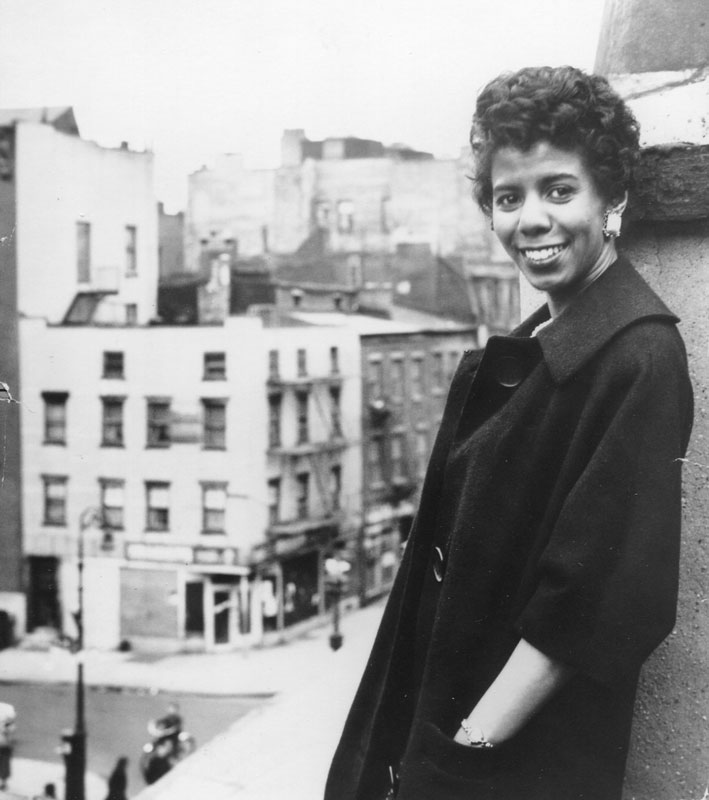
Lorraine Hansberry on the roof of 337 Bleeker Street, NYC her west Village apartment where she lived with her husband Robert Nemiroff. Photo by Nat Fein.
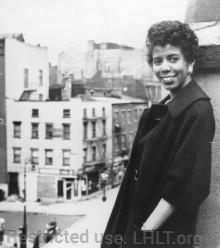 Lorraine Hansberry on the roof of 337 Bleeker Street, NYC.
Lorraine Hansberry on the roof of 337 Bleeker Street, NYC. 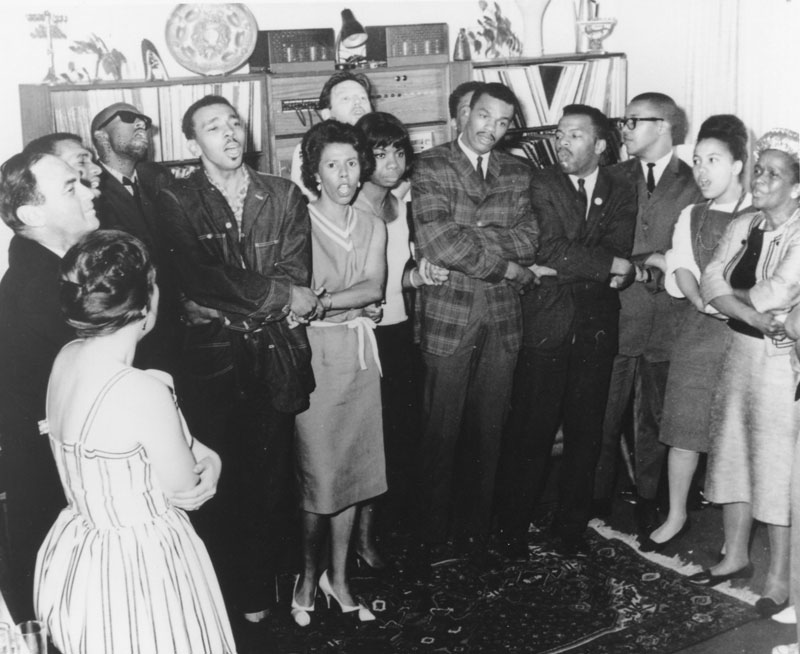
Lorraine Hansberry during “impromptu song-session” at a SNCC fundraiser at the home of actor and activist Theodore Bikel. Holding hands and singing are (left to right) Avon M. Rollins, Lorraine Hansberry, Theo Bikel, Nina Simone, Marion Barry, Jr., John Lewis, unidentified man, unidentified woman, Ella Baker. July 6,1963. The Student Nonviolent Coordinating grew out of a student meeting organized by Ella Baker at Shaw University in 1960. SNCC played a major role in the sit-ins, freedom rides, voter registration, the 1963 March on Washington, Mississippi Freedom Summer, and the Mississippi Freedom Democratic Party. SNCC supporters in the North raised funds for weekly salaries of $10 for SNCC workers in the South. Photo originally published in the New York Amsterdam News.
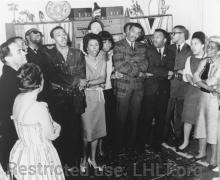 Lorraine Hansberry during “impromptu song-session” at a SNCC fundraiser at the home of actor and activist Theodore Bikel.
Lorraine Hansberry during “impromptu song-session” at a SNCC fundraiser at the home of actor and activist Theodore Bikel. 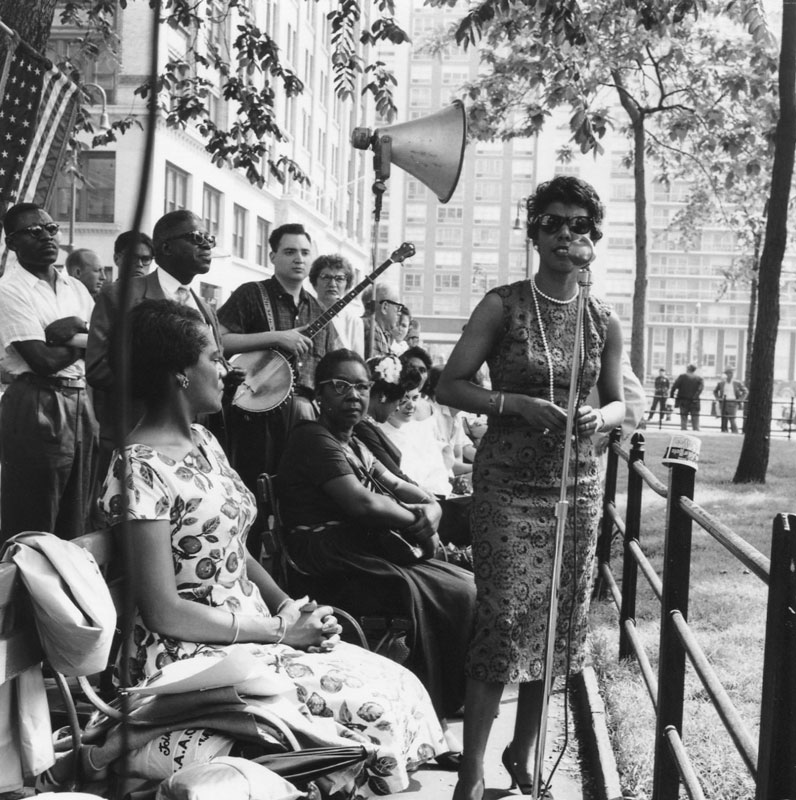
Daisy Bates and Lorraine Hansberry at “Village Rallies for NAACP,” in Washington Square Park, June 13, 1959. Photographer unknown. Hansberry was the co-chair of the National Association for the Advancement of Colored People Life Membership Committee. The rally was to increase membership, raise funds, and to start a Greenwich Village NAACP branch. Daisy Lee Gatson Bates was the president of the NAACP Arkansas State Conference of Branches and advisor to the Little Rock Nine, the high school students who desegregates the all-white Central High School in 1957.
 Unidentified woman, Daisy Bates, and Lorraine Hansberry at “Village Rallies for NAACP,” in Washington Square Park, June 13, 1959. Photographer unknown.
Unidentified woman, Daisy Bates, and Lorraine Hansberry at “Village Rallies for NAACP,” in Washington Square Park, June 13, 1959. Photographer unknown. 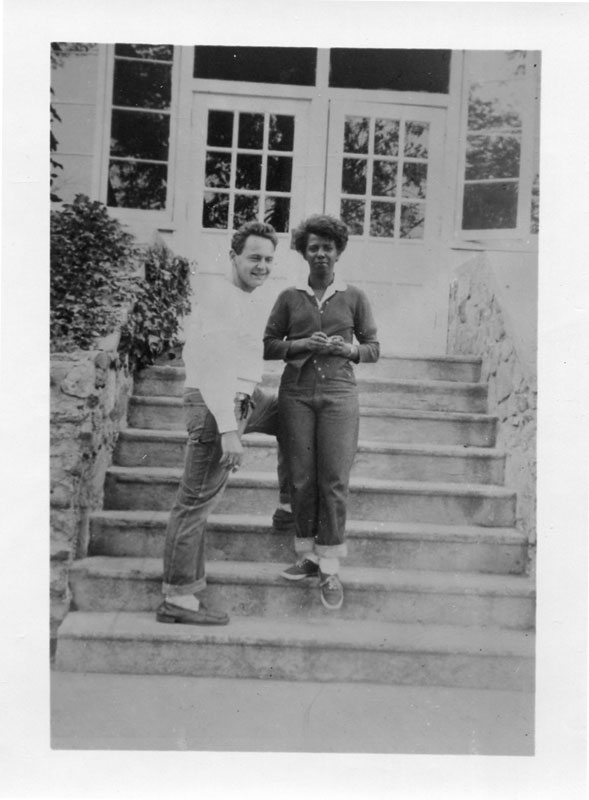
Robert Nemiroff and Lorraine Hansberry, on steps of building at Camp Unity, 1953 or 1954. Photographer unknown. Camp Unity was a left-wing interracial summer camp for adults in upstate Wingdale, New York. In 1954, Hansberry was the Lawn Program Director and invited speakers such as W.E.B. Du Bois and his wife, Shirley Graham Du Bois to visit. Phil Rose, who would later produce A Raisin in the Sun, was also on staff there.
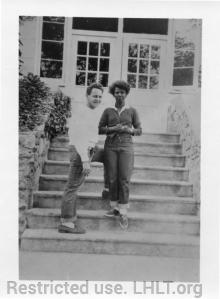 Robert Nemiroff and Lorraine Hansberry, on steps of building at Camp Unity, 1953 or 1954. Photographer unknown.
Robert Nemiroff and Lorraine Hansberry, on steps of building at Camp Unity, 1953 or 1954. Photographer unknown. 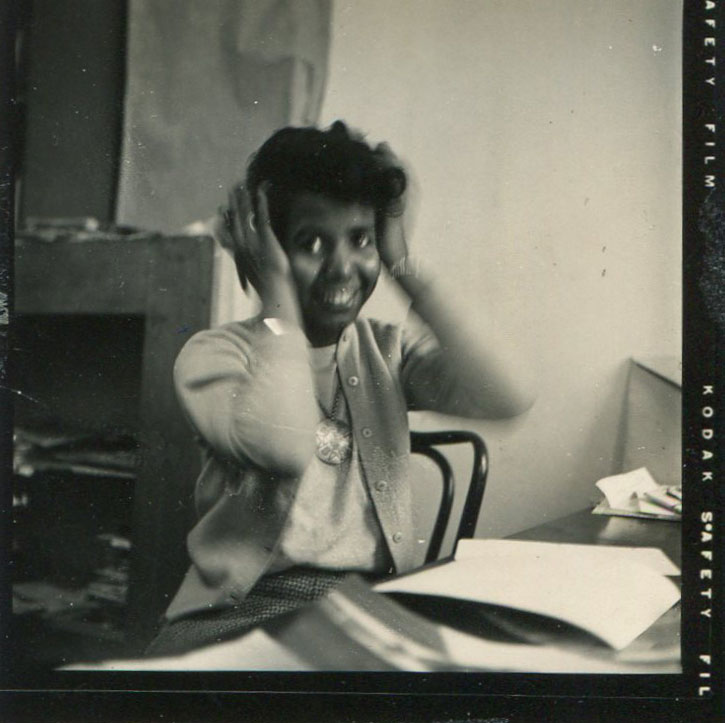
Lorraine Hansberry at her desk at Freedom magazine, 1952. Photographer unknown. From 1951–1953, Hansberry worked in Harlem at the weekly black newspaper, Freedom, founded by Paul Robeson and Louis E. Burnham. At the newspaper, Hansberry started as a “subscription clerk, receptionist, typist and editorial assistant” in addition to writing news articles and editorials. She soon became associate editor, working closely with Louis Burnham, who became her mentor.
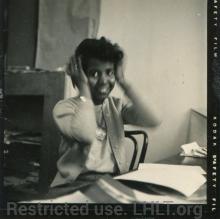 Lorraine Hansberry at her desk at Freedom magazine, 1952. Photographer unknown.
Lorraine Hansberry at her desk at Freedom magazine, 1952. Photographer unknown. 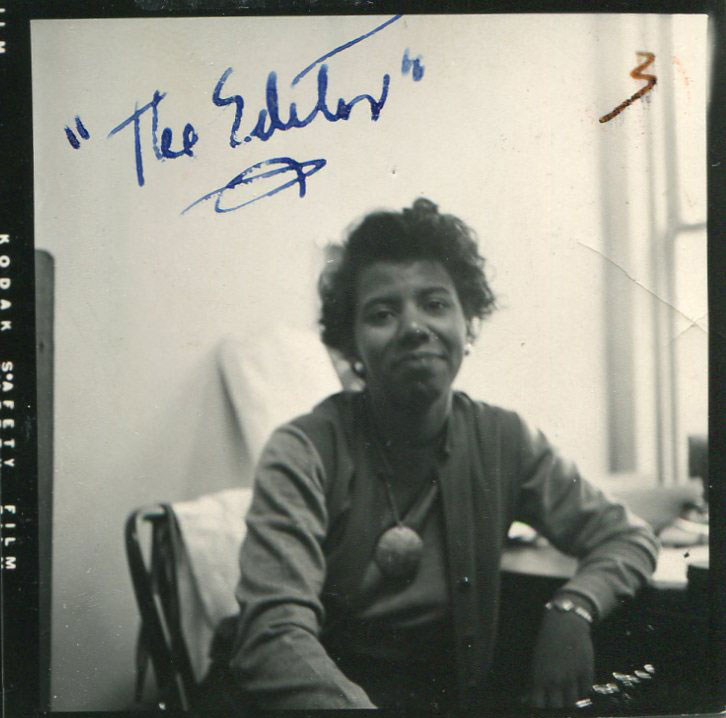
Lorraine Hansberry, “The Editor,” at her desk at Freedom magazine, 1952. Photographer unknown. From 1951–1953, Hansberry worked in Harlem at the weekly black newspaper, Freedom, founded by Paul Robeson and Louis E. Burnham. At the newspaper, Hansberry started as a “subscription clerk, receptionist, typist and editorial assistant” in addition to writing news articles and editorials. In December 1952, Hansberry was named associate editor, working closely with Burnham who became her mentor.
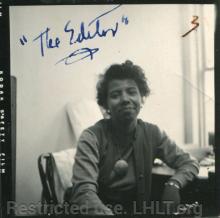 Lorraine Hansberry, “The Editor,” at her desk at Freedom magazine, 1952. Photographer unknown.
Lorraine Hansberry, “The Editor,” at her desk at Freedom magazine, 1952. Photographer unknown. 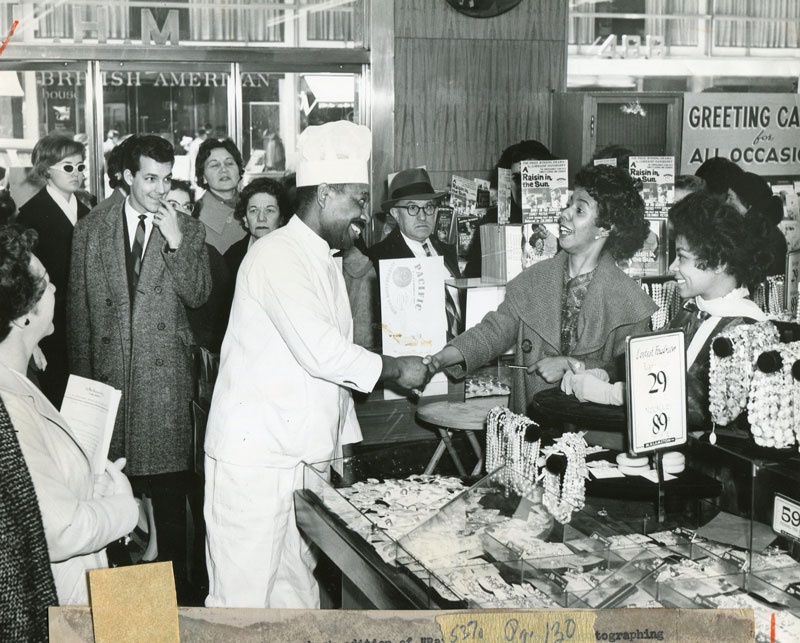
Lorraine Hansberry shakes hands with chef at Lamston’s variety store on Madison Avenue & 51st Street, NYC after autographing a Signet paperback edition for him. With Hansberry, on the right, is Ruby Dee, one of the stars of the motion picture version of the play. May 15, 1961. Ross Photos.
 Lorraine Hansberry shakes hands with chef at Lamston’s variety store on Madison Avenue & 51st Street, NYC after autographing a Signet paperback edition for him.
Lorraine Hansberry shakes hands with chef at Lamston’s variety store on Madison Avenue & 51st Street, NYC after autographing a Signet paperback edition for him. 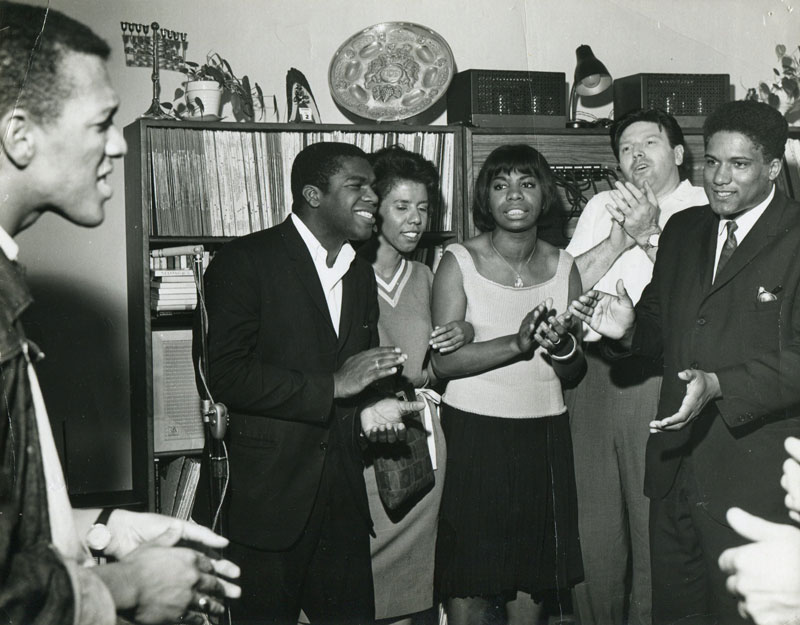
Lorraine Hansberry during “impromptu song-session” at a SNCC fundraiser at the home of actor and activist Theodore Bikel. Clapping hands and singing are (left to right) Ivanhoe Donaldson Chuck McDew, Lorraine Hansberry, Nina Simone, Theodore Bikel, and James Forman. The Student Nonviolent Coordinating grew out of a student meeting organized by Ella Baker at Shaw University in 1960. SNCC played a major role in the sit-ins, freedom rides, voter registration, the 1963 March on Washington, Mississippi Freedom Summer, and the Mississippi Freedom Democratic Party. SNCC supporters in the North raised funds for weekly salaries of $10 for SNCC workers in the South. Photo originally published in the New York Amsterdam News.
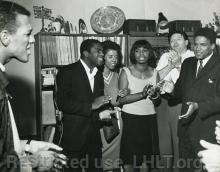 Lorraine Hansberry during “impromptu song-session” at a SNCC fundraiser at the home of actor and activist Theodore Bikel.
Lorraine Hansberry during “impromptu song-session” at a SNCC fundraiser at the home of actor and activist Theodore Bikel. 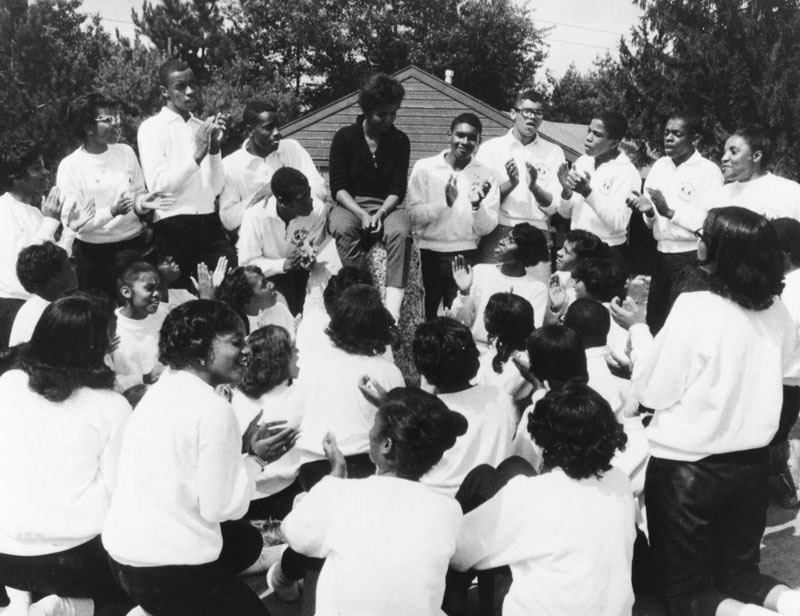
Lorraine Hansberry giving the Tapawingo leadership presentation to group of African American youth at Camp Minisink, Port Jervis, NY in August, 1960. Photo by Gin Briggs. The New York City Mission Society operated Camp Minisink, the first sleep-away camp for impoverished African American children and teens from NYC. The Tapawingo Honor Society, founded in 1942, was a program for young people as preparation for service as counselors at Camp Minisink.
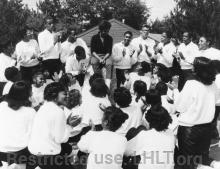 Lorraine Hansberry giving the Tapawingo leadership presentation to group of African American youth at Camp Minisink, Port Jervis, NY in August, 1960. Photo by Gin Briggs.
Lorraine Hansberry giving the Tapawingo leadership presentation to group of African American youth at Camp Minisink, Port Jervis, NY in August, 1960. Photo by Gin Briggs. 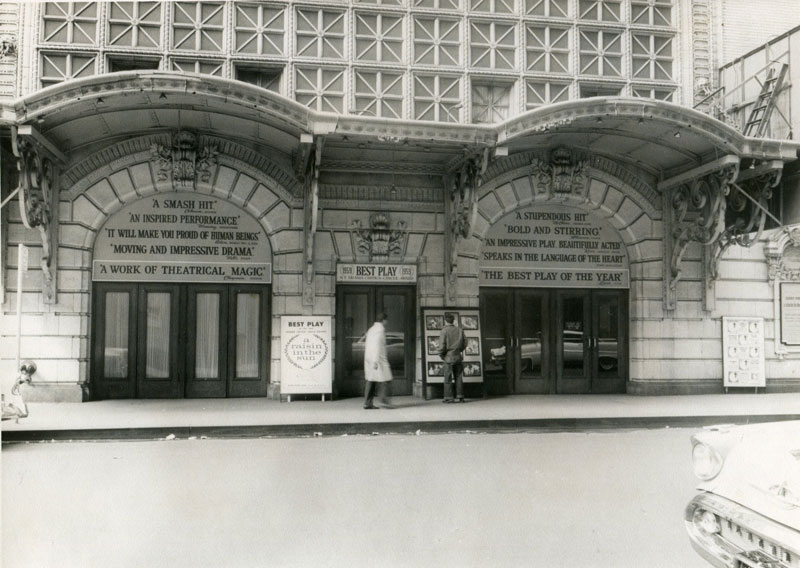
The theatrical posters from A Raisin in the Sun at the Ethel Barrymore Theater, which opened on March 11, 1959. A Raisin in the Sun played at the Barrymore through October 17, 1959 and then moved to the Belasco Theater where it closed on June 25, 1960 after a total of 530 performances. Photo by Gin Briggs.
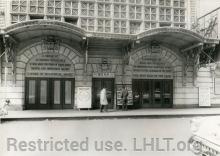 The theatrical posters from A Raisin in the Sun at the Ethel Barrymore Theater, which opened on March 11, 1959.
The theatrical posters from A Raisin in the Sun at the Ethel Barrymore Theater, which opened on March 11, 1959. 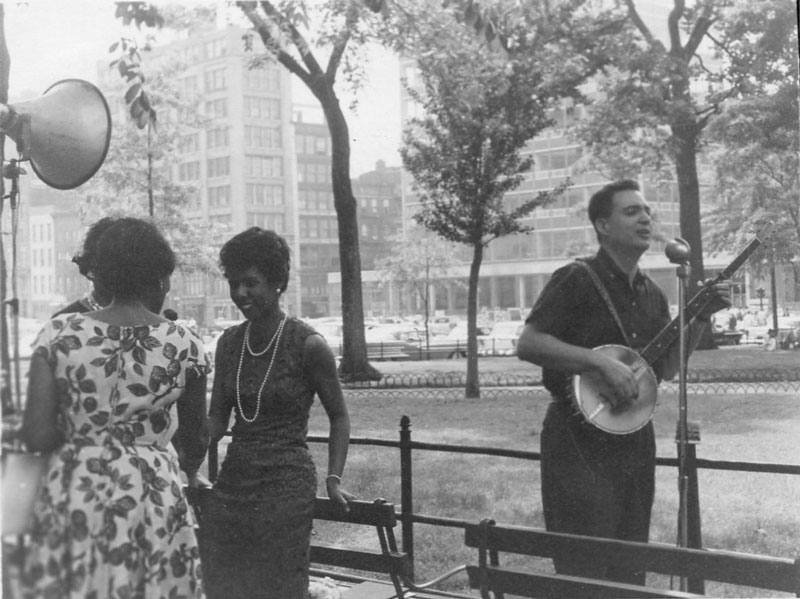
Unidentified woman, Lorraine Hansberry, and folk musician David Sears at “Village Rallies for NAACP,” in Washington Square Park, June 13, 1959. Photographer unknown. Hansberry was the co-chair of the National Association for the Advancement of Colored People Life Membership Committee. The rally was to increase membership, raise funds, and to start a Greenwich Village NAACP branch.
 Unidentified woman and Lorraine Hansberry at “Village Rallies for NAACP,” in Washington Square Park, June 13, 1959. Photographer unknown.
Unidentified woman and Lorraine Hansberry at “Village Rallies for NAACP,” in Washington Square Park, June 13, 1959. Photographer unknown. 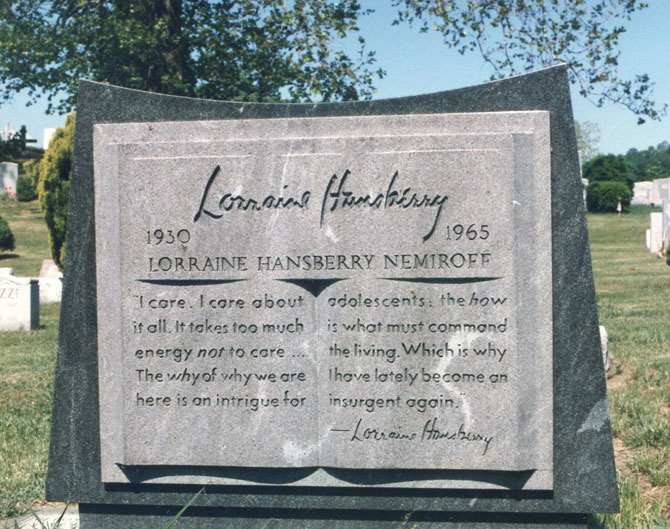
Memorial gravestone of Lorraine Hansberry who died on January 12, 1965 at the age of 34 from pancreatic cancer. Hansberry is buried at the Bethel Cemetery in Croton-on-Hudson, Westchester County, NY. The text on her gravestone is from The Sign in Sidney Brustein’s Window: “I care. I care about it all. It takes too much energy not to care. The why of why we are here is an intrigue for adolescents. The how is what must command the living which is why I have lately become an insurgent again.”
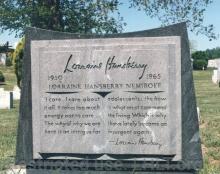 Memorial gravestone of Lorraine Hansberry who died on January 12, 1965 at the age of 34 from pancreatic cancer.
Memorial gravestone of Lorraine Hansberry who died on January 12, 1965 at the age of 34 from pancreatic cancer. 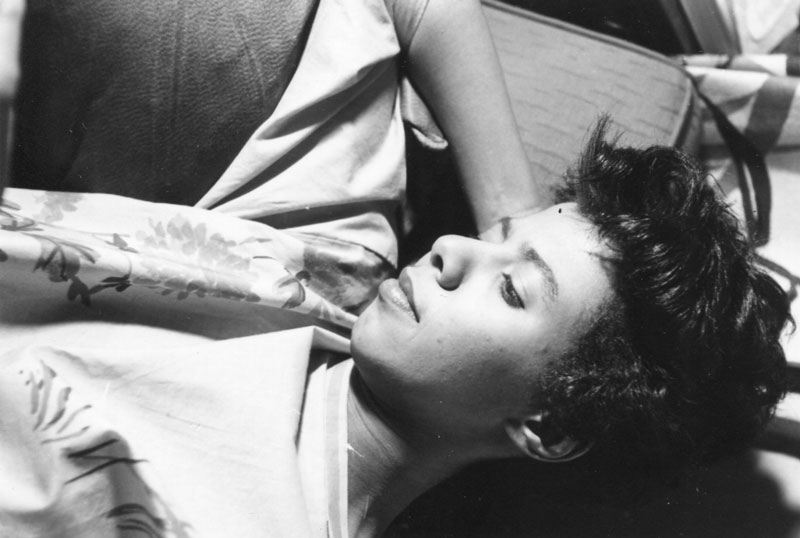
Lorraine Hansberry reclining on couch at home. Photo by Gin Briggs. Gin Briggs was a staff photographer for the Village Voice. Briggs had a small storefront studio on Christopher Street and lived upstairs from Hansberry. They became great friends, with Briggs shooting several commercial and personal photo essays of Hansberry.
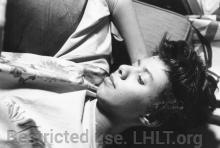 Lorraine Hansberry reclining on couch at home. Photo by Gin Briggs.
Lorraine Hansberry reclining on couch at home. Photo by Gin Briggs. 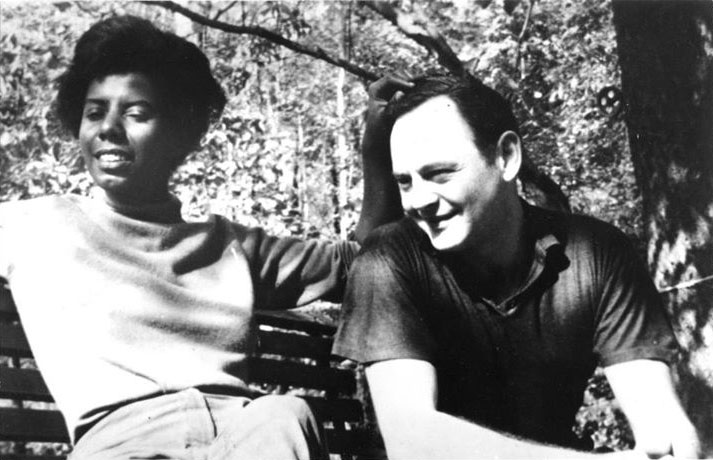
Lorraine Hansberry playing with Robert Nemiroff’s hair in the backyard of their home in Croton-on-Hudson. Hansberry and Nemiroff met in 1952, on a picket line protesting the segregation of New York University basketball teams. The son of Russian Jewish immigrants, Nemiroff was completing a graduate degree in English at NYU. They married in 1953 and divorced in 1964; Hansberry named Nemiroff as the executor of her literary estate.
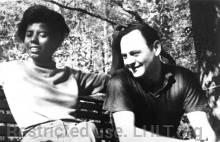 Lorraine Hansberry playing with Robert Nemiroff’s hair in the backyard of their home in Croton-on-Hudson.
Lorraine Hansberry playing with Robert Nemiroff’s hair in the backyard of their home in Croton-on-Hudson. - « first
- ‹ previous
- 1
- 2
- 3